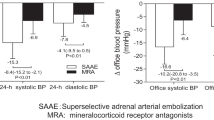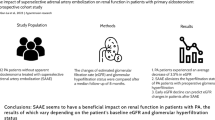Abstract
Renal arterial embolization and subsequent nephrectomy or nephrectomy alone were performed in 34 patients with renal cell carcinoma. Renal arterial embolization caused a blood pressure elevation concomitant with an increase in plasma renin activity (PRA), urinary aldosterone excretion or urinary prostaglandin (PGE2) excretion. Subsequent nephrectomy normalized hypertension and reduced the levels of these vasoactive substances. There were significant relationships between the increase in mean blood pressure and the increase in PRA, the increment in mean blood pressure and the increment in urinary aldosterone excretion, and the increase in PRA and increase in log urinary PGE2 excretion following embolization. These evidences suggest that enhancement of the renin-angiotensin-aldosterone system participates in the development of hypertension following embolization, and increased PRA may play an important role in the release of urinary PGE2.
Similar content being viewed by others
References
Brenner, B. M., Troy, J. L.: Postglomerular vascular protein concentration: evidence for a causal role in governing fluid reabsorption and glomerular balance by the renal proximal tubule.J. Clin. Invest., 50, 336 (1971).
Blum, M., Bauminger, S., Algneti, A., Kisch, E., Ayalon, D., Aviram, A.: Urinary prostaglandin E2 in chronic renal disease.Clin. Nephrol., 15, 87 (1981).
Dray, F., Charvonnel, B., Maclouf, J.: Radioimmunoassay of prostaglandin F, F1 and E2 in human plasma.J. Clin. Invest., 5, 311 (1975).
Falcuk, K., Brenner, B. M., Tadokoro, M., Berliner, R. W.: Oncotic and hydrostatic pressures in peritubular capillaries and fluid reabsorption by proximal tubule.Am. J. Physiol., 220, 1427 (1971).
Gill, J. R., Jr., Frőlich, J., Bowden, R. E., Taylor, A. A., Keiser, H. R., Seyberth, H. W., Oates, J. A., Bartter, F. C.: Bartter's syndrome: a disorder characterized by high urinary prostaglandins and a dependence of hyperreninemia on prostaglandin synthesis.Am. J. Med., 61, 43 (1976).
Gross, J. B., Bartter, F. C.: Effects of prostaglandin E1, A1 and F2α on renal handling of salt and water.Am. J. Physiol., 225, 218 (1973).
Groshaw, K., Szlyk, J. Z.: Distribution of prostaglandins in rabbit kidney.Biochem. J., 116, 421 (1970).
Jaffe, B. M., Parker, C. W., Marshall, G. R., Needleman, P.: Renal concentrations of prostaglandin E in acute and chronic renal ischemia.Biochem. Biophys. Res. Commun., 49, 799 (1972).
Katz, F. H., Smith, J. A.: Radioimmunoassay of angiotensin I: comparison of two renin activity methods and use for other measurements of the renin system.Clin. Chem., 18, 528 (1972).
Laragh, J. H.: The classification and treatment of essential hypertension using the renin-sodium index for vasoconstriction-volume analysis.The Johns Hopkins Med. J., 137, 184 (1975).
Larsson, C., Änggård, E.: Regional differences in the formation and metabolism of prostaglandins in the rabbit kidney.Eur. J. Pharmacol., 21, 30 (1973).
Malik, K. U.: Prostaglandins—modulation of adrenergic nervous system.Fed. Proc., 37, 203 (1978).
McGiff, J. C., Crowshaw, K., Terragno, N. A., Lonigro, A. J., Strand, J. C., Williamson, M. A., Lee, J. B.: Prostaglandin-like substances appearing in canine renal venous blood during renal ischemia.Circ. Res., 27, 765 (1970).
Messina, E. J., Weiner, R., Kalley, G.: Prostaglandin and local circulatory control.Fed. Proc., 35, 2367 (1976).
Nakada, T., Yoshikawa, M., Ishikawa, S., Akiya, T., Yanagi, S., Katayama, T., Nishino, A., Wakaki, K.: Coexistence of renomedullary interstitial cells and juxtaglomerular cells after acute occlusion of renal artery.Urol. Int., 38, 78 (1983).
Rathaus, M., Podjarny, E., Weiss, E., Ravid, M., Bauminger, S., Bernheim, J.: Effect of chronic and acute changes in sodium balance on the urinary excretion of prostaglandin E2 and F2α in normal man.Clin. Sci. Mol. Med., 60, 405 (1981).
Robson, C. J.: Radical nephrectomy for renal cell carcinoma.J. Urol., 89, 37 (1963).
Remero, J. C., Strong, C. G.: The effect of indomethacin blockade of prostaglandin synthesis on blood pressure of normal rabbits and rabbits with renovascular hypertension.Circ. Res., 40, 35 (1977).
Tannenbaum, J., Splawinski, J. A., Oates, J. A., Nies, A. E.: Enhanced renal prostaglandin production in the dog. 1. Effects on renal function.Circ. Res., 36, 197 (1975).
Zawada, E. T. Jr., Dornfeld, L., Johnson, M., Tuck, M., Maxwell, M.: Defective renal prostaglandin synthesis in hypertensive patients with morbid obesity.Nephron, 39, 361 (1985).
Author information
Authors and Affiliations
Rights and permissions
About this article
Cite this article
Nakada, T., Koike, H. & Katayama, T. Changes of vasoactive substances following embolization for renal cell carcinoma. International Urology and Nephrology 20, 569–576 (1988). https://doi.org/10.1007/BF02549489
Received:
Issue Date:
DOI: https://doi.org/10.1007/BF02549489




